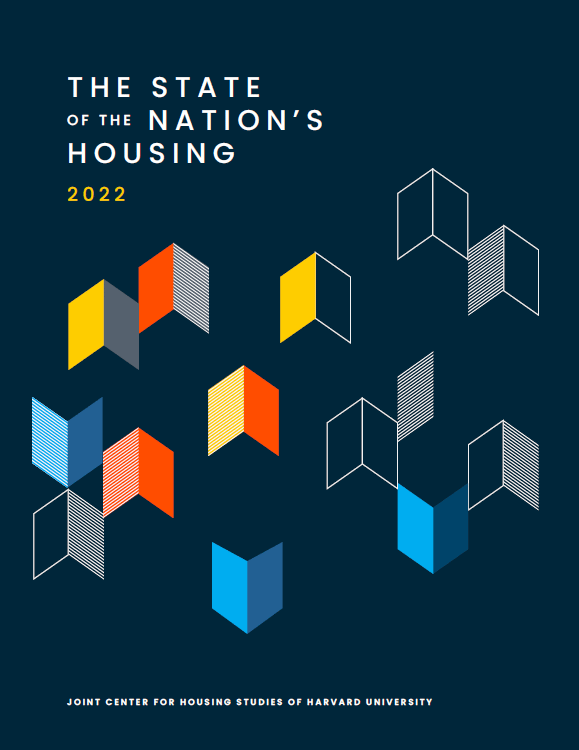Some 4 million renter households have been priced out of homeownership in the past year due to rising home prices and mortgage interest rates. Eroding affordability was among findings in the latest State of the Nation’s Housing report from Harvard’s Joint Center for Housing Studies.

Authors of the 48-page report described the housing market as being at an inflection point, noting the surge in prices of gas, food and other necessities has made matters worse, “especially now that most emergency government supports have ended.”
On a brighter note, researchers believe the large number of apartments under construction should bring some relief on the rental side. Nonetheless, they suggested the pressure of high housing costs is “unlikely to relent” for lower-income households and households of color.
To illustrate the impact of changes in prices and interest rates, researchers tabulated year-over-year increases and the resulting effect on a potential owner’s cost. JCHS staff based their analysis on data from Freddie Mac, primary mortgage market surveys, and existing sales figures from the National Association of REALTORS®.
| April 2021 | April 2022 | Change 2021 – 2022 | |
| Interest Rate (percent) | 3.06 | 4.98 | 1.92 |
| Median Home Price | $340,700 | $391,200 | $50,500 |
| Downpayment and Closing Costs | $22,100 | $25,400 | $3,300 |
| Monthly Mortgage Payment | $1,400 | $2,020 | $620 |
| Total Monthly Owner Costs | $2,060 | $2,780 | $720 |
| Annual Income Needed | $79,600 | $107,600 | $28,000 |
Total monthly payments rose by at least $500 since a year ago in 70 of the 100 largest metro areas, including 30 metros where owner costs spiked more than $1,000 per month.
In the Seattle-Tacoma-Bellevue region, where the median home price was pegged at $811,553, the increases mean the estimated mortgage payment would be $4,196; with the addition of other costs, the estimated monthly payment climbs to $5,765.
Nationwide, JCHS calculated home price appreciation in March 2022 was 20.6%, marking the largest jump in 30 years of recordkeeping. “Severe constraints” on supply are blamed for much of the record surges, with surprisingly strong household growth during the pandemic being a contributing factor.
Further pressure on prices is attributed to investors who are buying up moderately priced homes either to convert to rentals or to upgrade and resell. The report cites findings by CoreLogic which found the investor share of single family home sales during first quarter 2022 hit 28%, a sharp increase from a year earlier when investors accounted for 19% of such sales.
More and more households are being priced out of homeownership and related benefits such as the potential to build significant wealth through home equity, according to the JCHS report. The challenge coincides with a time when households of color need increased access to narrow wide racial gaps.
While the homeownership rate for non-Hispanic white households is 74.6%, it is only 48.3% for Hispanic households and 46.0% for non-Hispanic Black households.
- In addition to longstanding racial inequities, the JCHS report outlines several other challenges, including:
- The affordability squeeze. Nearly a third of households are cost burdened, spending more than 30% of their income on housing costs; among renters, roughly 46% are at least moderately cost burdened.
- Rising housing instability. Coinciding with ending government protections, eviction filings started climbing.
- One-time allocations from remaining relief measures to support both renters and homeowners in distress.
- Longer-term assistance needs. An estimated 7.8 million unassisted households with very low incomes had severe costs burdens and/or lived in severely inadequate housing. “The stopgap measures put in place over the past two years underscore the need for substantial, consistent investment in affordable rental housing,” the authors wrote. They found that chronic underinvestment in HUD-funded programs has left the stock of 932,000 public housing units with capital needs estimated at $81 billion in 2020.
- Expanding the market-rate supply of both for sale and for rent housing. State and local zoning reforms, repurposing commercial properties vacated during the pandemic, and adoption of more efficient construction methods are among ways to boost sources of housing.
- Meeting the needs of an aging population. The number of households headed by adults age 65 and over is projected to surge from around 33 million in 2018 to more than 50 million in 2038. That increase is escalating the need for accessible housing.
- Growing risks from climate change. The cost of disaster repairs for homeowners has jumped 117% from 2009-2019. “In addition to threatening the homes and lives of residents, weather-related disasters pose serious risks to the housing finance system,” the report states, with a call for Fannie Mae and Freddie Mac to make the system more resilient, and for incentives for owners in high-exposure areas to either mitigate their risk or relocate.
- Mitigating housing’s environmental impacts. The residential sector generates about a fifth of the nation’s direct greenhouse gas emissions, prompting a call for stricter requirements for the energy efficiency of new homes, energy-efficient retrofits of existing homes, and a shift toward electrification and renewable energy sources.
In their outlook, authors of The State of the Nation’s Housing emphasized developing the policies and practices to meet housing needs will take “concerted efforts by both the public and private sectors.”
Principal funding for the report was provided by the Policy Advisory Board of the Joint Center for Housing Studies and Wells Fargo, along with support from more than a dozen other entities.